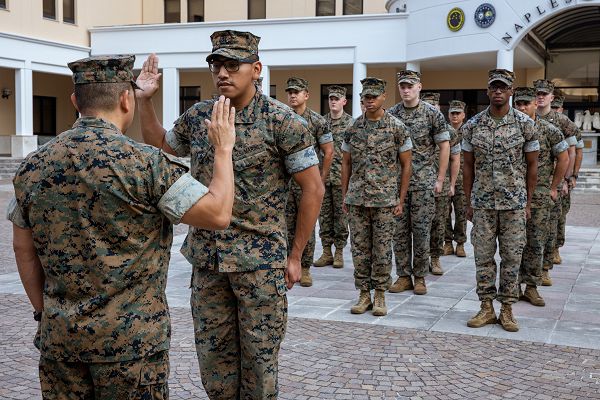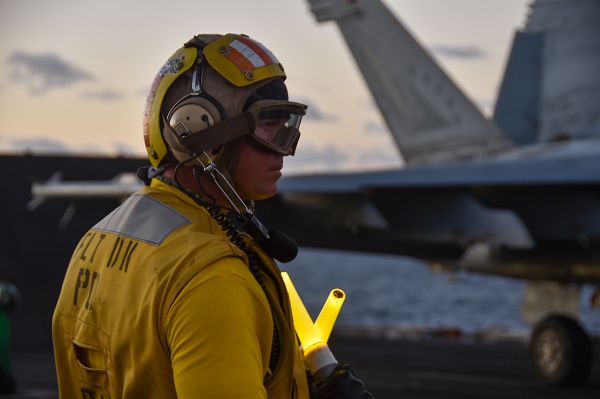- Details
- Hits: 550

Tuskegee Airmen Honored 75 Years After Desegregation Of Military
Join Base Andrews, Maryland. (July 26, 2023): In this photo by Senior Airman Tyrone Thomas, Retired Colonel Carl C. Johnson, a Tuskegee Airman, is interviewed during a ceremony celebrating the 75th anniversary of the desegregation of America’s armed forces.
Colonel Johnson was born in Bellaire, Ohio in 1926.He attended Ohio State University until he was drafted into the U.S. Army Air Force in 1945. In October 1946, he and fourteen other African American draftees entered the Tuskegee Army Air Force aviation cadet program. He served as a member of the 477th Bombardment Group Composite’s 617th Bomber Squadron and was discharged in 1947.
Johnson later returned to active duty as a U.S. Army aviator during the Korean War.
During the Vietnam War, Johnson commanded a seven-company aviation battalion and later Commanded a US Army Aviation Battalion in the Republic of South Korea. Johnson retired from the US Air Force with the rank of Colonel after 31 years in the U.S. military.
The Tuskegee Airmen were a group of African American military pilots (fighter and bomber) and airmen who fought in World War II. The name also applies to the navigators, bombardiers, mechanics, instructors, crew chiefs, nurses, cooks, and other support personnel. The Tuskegee pilots received praise for their excellent combat record earned while protecting white American bombers from enemy fighters. The group was awarded three Distinguished Unit Citations.
When the Tuskegee aviators painted the tails of their P-47s Mustang planes red, the nickname "Red Tails" was coined as the nickname for the first African American military aviators in the United States Armed Forces. During World War II, black Americans in many U.S. states were still subject to Jim Crow laws and the American military was racially segregated, as was much of the federal government. The Tuskegee Airmen were subjected to discrimination, both within and outside of the army, during their service.
Read more: TUSKEGEE AIRMEN HONORED 75 YEARS AFTER DESEGREGATION OF MILITARY
- Details
- Hits: 578

Pacific Ocean. (July 27, 2023) In this photo by MC2 Joshua Samoluk, Sailors assigned to the amphibious transport dock ship USS John P. Murtha and Explosive Ordnance Disposal Expeditionary Support Unit 1 launch the Vehicle Advanced Demonstrator for Emergency Recovery, or VADR, during an Underway Recovery Test at sea. VADR is a replica of the crew module that will be used during NASA's Artemis II mission to send four astronauts to the Moon and beyond.
NASA and the Navy will conduct a series of tests to demonstrate and evaluate the processes, procedures, and hardware used in these recovery operations for lunar missions. The U.S. Navy has unique capabilities that make it an ideal partner to support NASA, including its amphibious capabilities and the ability to deploy helicopters, launch and recover small boats, three-dimensional air search radar, and advanced medical facilities.
Artemis II is the second scheduled mission of NASA’s Orion spacecraft due to launch in November 2024. This will be the first crewed spacecraft to travel beyond earth’s low orbit to return to the moon since the Apollo 17 mission in 1972.
Artemis II will carry four astronauts, including the first woman, first person of color, and first non-American to travel beyond low Earth orbit. The first woman is to be Christina Koch, who will serve as a mission specialist and the first person of color is to be Victor J. Glover, who will pilot the aircraft. The non-American is Jeremy Hansen from Canada.
This will be the second flight into space for Astronaut Koch who set a record for the longest single space flight by a woman (328 days) and she participated in the first all-female space walks.
- Details
- Hits: 509

Queensland, Australia.(July 24, 2023): In this photo by Corporal Brayden Daniel, Marine 1st Lieutenant Joshua Watson, executive officer with Lima Company, 3rd Battalion, 1st Marine Regiment watches as an MV-22B Osprey tiltrotor aircraft lands during Exercise Southern Jackaroo 23. Southern Jackaroo is a trilateral exercise involving the Japanese Ground Self-Defense Force, observers from South Korea, and the Australian Defense Force.
Each year, hundreds of Australian soldiers, troops from the Japanese Ground Self Defense Force, and U.S. Marines conduct major warfighting exercises at Queensland’s Shoal Water Bay training area. The goal is to share tactics, techniques, and procedures while also improving interoperability among their military capabilities. This year’s event featured shooters cycling through training lanes consisting of small arms close combat, patrolling, and infantry live fire and tank integration involving the three distinct forces.
Unique to Southern Jackaroo 23 was the addition of a long-range casualty evacuation from Shoal Water Bay to Darwin using a care team aboard an MV-22 Osprey to transport and treat a simulated casualty. The Osprey flew from the Queensland training area back to RAAF Base Darwin using aerial refueling and staffed by a critical care team from MRF-D’s Role II facility.
- Details
- Hits: 537

Moody Air Force Base, Georgia. (July 25, 2023): In this photo by Air Force Captain Katie Tamesis, a 45th Security Forces Squadron military working dog handler and K9 partner conduct fast rope insertion and extraction training from a HH-60W Jolly Green II helicopter. The 45th Security Forces Squadron, based at Patrick Space Force Base, came to the 93rd Air Ground Operations Wing headquarters at Moody AFB to train with the 820th Base Defense Group. The goal was to bolster air mobility employment capabilities of military working dog teams.
Most dog owners have witnessed their pet’s fear and anxiety brought on by sudden loud noises like thunder or fireworks on the 4th of July. There are even companies that sell “thunder shirts” to calm pets during these noisy events.
Which begs the question; “How in the world do these military K-9 teams get their dogs to join them as they fast rope to the ground amid the roar of helicopter blades and bombs exploding all around?”
That is the specialty of the Air Force Dog Handler Team program which trains the 1300 working dog teams worldwide including those from the Army, Navy, and Marine Corps. In addition to traditional explosives and drug detection duties, the Dog Handler Team Program exposes K-9s to the sight, sound, smell, feel, and raw environment of a helicopter while its handler rappels the team to the ground.
The teams begin by familiarizing their dog with the entry and exit of the aircraft and, once they are comfortable with moving in and out of the chopper, the pilot fires up the engines and the real challenge begins. Both working dogs and handlers are equipped with hearing protection and as they practice boarding and exiting the chopper multiple times before the helicopter blades come to a stop.
- Details
- Hits: 568

Naples, Italy. (July 20, 2023): In this photo by Lance Corporal Jack Labrador, U.S. Marine Corps Corporal Eduardo Garcia, Data System Administrator, 2nd Marine Expeditionary Brigade, recites the Oath of Enlistment during his reenlistment ceremony under the under the Commandant’s Retention Program (CRP) at Naval Support Site Naples, Italy. The CRP expedites the reenlistment process for selected Marines and offers them meaningful incentives to reenlist, such as assignment prioritization, to help retain the most talented first term marines.The overall military retention rate for the US is 55% with the Army having the highest overall attrition rate and the Marine Corps having the lowest. According to data from the Defense Manpower Data Center, the reenlistment rates for the four US military branches in Fiscal Year 2021 were as follows:
- United States Air Force: 66.8%
- United States Navy: 59.6%
- United States Coast Guard: 59.1%
- United States Marine Corps: 56.2%
- United States Army: 48.3%
One factor having a significant impact on retention is the number of deployments servicemembers are asked to make.
- Details
- Hits: 560

INDIAN OCEAN (July 19, 2023): In this photo by MC3 Natasha Chevalier-Losada, Aviation Boatswain’s Mate (Aircraft Handling) 1st Class Jarred Scifert, from Monticello, Indiana, directs aircraft on the flight deck aboard the U.S. Navy’s only forward-deployed aircraft carrier, USS Ronald Reagan in the Indian Ocean. The Ronald Reagan is the flagship of Carrier Strike Group 5, a combat-ready force that protects and defends the United States in the Indo Pacific region.
Aviation Boatswain’s Mate (Aircraft Handling) is one of the most important roles in naval aviation and is responsible for helping launch and recover aircraft quickly and safely aboard ships at sea. Their duties also include firefighting, salvage, and rescue operations.
Aircraft handlers work outdoors on the deck of aircraft carriers that launch aircraft every 20 seconds in all climatic conditions in fast-paced and often potentially hazardous environments. They are called the “salt of the deck” by pilots as they supervise the safe movement of aircraft on busy flight decks in all-weather day and night. In the event of a crash, the Aircraft Handlers help rescue personnel, perform firefighting duties, and do debris removal.
To become a Navy Aircraft Handler, a candidate must pass ten weeks of Basic Recruit Training at Great Lakes, Michigan and then complete four weeks specialized training at Pensacola, Florida. Upon graduation, the Boatswain’s Mate (Aircraft Handling) may be assigned to an aircraft carrier or other types of ships with airplanes or helicopters.


